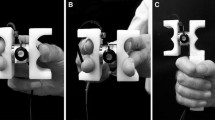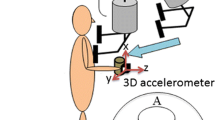Abstract
Grip force adaptation to Coriolis and centrifugal force perturbations was tested in healthy subjects. Eight subjects were seated in a rotating chamber in a rotating axis position. They each grasped an instrumented object resting on the thumb, which was stabilized by the other fingers from above. Subjects performed horizontal point-to-point movements with the grasped object away and towards the trunk. These movements were directed in a nonparallel fashion towards the axis of rotation prior (40 pre-rotational movements), during (80 per-rotational movements) and following (40 post-rotational movements) clockwise body rotation. During pre- and post-rotational movements two load force peaks of similar magnitude occurred during the acceleratory and deceleratory phases of the movements. Accordingly, a Coriolis force, which was orthogonal and proportional to the linear velocity of the moving arm, as well as a centrifugal force proportional to the system’s squared angular velocity and movement amplitude developed during per-rotational movements. The load perturbations altered the load force profile in a characteristic way. The first 10 per-rotational movement sequence revealed that there was a less precise coupling between grip and load force magnitudes and a reduced temporo-spatial co-ordination between grip and load force profiles. With increasing number of per-rotational movements, there was significant improvement in the temporo-spatial co-ordination and in the coupling in force magnitude between grip and load force profiles, indicating an ongoing adaptation process. The coupling between grip and load forces proved to be similarly precise for the last 10 per-rotational movements and for pre-rotational movements, suggesting complete adaptation. Significant effects were observed for the first post rotational movements following adaptation to the per-rotational load characteristics both for the temporal co-ordination between grip and load forces and for the coupling in force magnitudes. However, the last 10 post-rotational movements proved to be similarly precise with comparison to pre-rotational performance in terms of grip force regulation with movement-induced loads. The results are discussed within the context of the CNS ability to use internal models when planning and processing anticipatory grip force adjustments during manipulative tasks.






Similar content being viewed by others
References
Blakemore SJ, Goodbody SJ, Wolpert DM (1998) Predicting the consequences of our own actions: the role of sensorimotor context estimation. J Neurosci 18:7511–7518
Bortolami SB, Pigeon P, Lackner JR, DiZio P (1999) Self-generated Coriolis forces on the arm during natural turning and reaching movements. Soc Neurosci Abstr 25:1912
Cohn JV, DiZio P, Lackner JR (2000) Reaching during virtual rotation: context specific compensations for expected Coriolis forces. J Neurophysiol 83:3230–3240
Cole KJ, Rotella DL, Harper JG (1999) Mechanisms of age-related changes for fingertip forces during precision gripping and lifting in adults. J Neurosci 19:3238–3247
Dichgans J, Brandt T (1994) The psychophysics of visually induced perception of self-motion and tilt. In: Schmidt FO, Worden FG (eds) The neurosciences. MIT Press, Cambridge, MA, pp 123–129
DiZio P, Lackner JR (1995) Motor adaptation to Coriolis force perturbations of reaching movements: endpoint but not trajectory adaptation transfers to the non-exposed arm. J Neurophysiol 74:1787–1792
DiZio P, Lackner JR (2000a) Congenitally blind individuals rapidly adapt to Coriolis force perturbations of their reaching movements. J Neurophysiol 84:2175–2180
DiZio P, Lackner, JR (2000b) Coriolis-force-induced trajectory and endpoint deviations in the reaching movements of labyrinthine-defective subjects. J Neurophysiol 85:784–789
Flanagan JR, Johansson RS (2002) Hand movements. In: Ramshandran VS (ed) Encyclopedia of the human brain, vol 2. Academic Press, San Diego, pp 399–414
Flanagan JR, Vetter P, Johansson RS, Wolpert DM (2003) Prediction precedes control in motor learning. Curr Biol 13:146–150
Flanagan JR, Wing AM (1993) Modulation of grip force with load force during point-to-point movements. Exp Brain Res 95:131–143
Flanagan JR, Wing AM (1995) The stability of precision grip force during cyclic arm movements with a hand-held load. Exp Brain Res 105:455–464
Flanagan JR, Wing AM (1997) The role of internal models in motion planning and control: evidence from grip force adjustments during movements of hand-held loads. J Neurosci 17:1519–1528
Häger-Ross C, Cole KJ, Johansson RS (1996) Grip-force responses to unanticipated object loading: load direction reveals body- and gravity-referenced intrinsic task variables. Exp Brain Res 110:142–150
Häger-Ross C, Johansson RS (1996) Nondigital afferent input in reactive control of fingertip forces during precision grip. Exp Brain Res 110:131–141
Hermsdörfer J, Marquardt C, Zierdt A, Philipp J, Nowak DA, Mai N (2000) Moving weightless objects: Grip force control during microgravity. Exp Brain Res 132:52–64
Hermsdörfer J, Hagl E, Nowak DA, Marquardt C (2003) Grip force control during object manipulation in cerebral stroke. Clin Neurophysiol 114:951–929
Johansson RS, Edin BB (1993) Predictive feedforward sensory control during grasping and manipulation in man. Biomed Res 14:95–106
Johansson RS, Riso R, Häger C, Bäckström L (1992a) Somatosensory control of precision grip during unpredic pulling loads. I. Changes in load force amplitude. Exp Brain Res 89:181–191
Johansson RS, Häger C, Riso R (1992b) Somatosensory control of precision grip during unpredictable pulling loads. II. Changes in load force rate. Exp Brain Res 89:192–203
Johansson RS, Westling G (1984) Roles of glabrous skin receptors and sensorimotor memory in automatic control of precision grip when lifting rougher or more slippery objects. Exp Brain Res 56:550–564
Johansson RS, Westling G (1988) Programmed and triggered actions to rapid load changes during precision grip. Exp Brain Res 71:72–80
Lackner JR, DiZio P (1994) Rapid adaptation to Coriolis force perturbation of arm trajectory. J Neurophysiol 72:299–313
Lackner JR, DiZio, P (1998) Adaptation in a rotating artificial gravity environment. Brain Res Rev 28:194–202
Macefield VG, Häger-Ross C, Johansson RS (1996) Control of grip force during restraint of an object held between finger and thumb: Responses of cutaneous afferents from the digits. Exp Brain Res 108:155–171
Miall RC, Wolpert DM (1996) Forward models for physiological motor control. Neural Networks 9:1265–1279
Nowak DA, Hermsdörfer J, Philipp J, Marquardt C, Glasauer S, Mai N (2001) Effects of changing gravity on anticipatory grip force control during point-to-point movements of a hand-held object. Motor Control 5:231–253
Nowak DA, Glasauer S, Meyer L, Mai N, Hermsdörfer J (2002a) The role of cutaneous feedback for anticipatory grip force adjustments during object movements and externally imposed variation of the direction of gravity. Somatosens Motor Res 19:49–60
Nowak DA, Hermsdörfer J, Marquardt C, Fuchs HH (2002b) Grip and load force coupling during vertical arm movements with a grasped object in cerebellar atrophy. Exp Brain Res 145:28–39
Nowak DA, Hermsdörfer J (2003) Digit cooling influences grasp efficiency during manipulative tasks. Eur J Appl Physiol 89:127–133
Pigeon P, Bortolami SB, DiZio P, Lackner JR (2003) Coordinated turn-and reach movements. I. Anticipatory compensation for self-generated Coriolis and interaction torques. J Neurophysiol 89:276–289
Sperry RW (1950) Neural basis of spontaneous optokinetic responses produced by visual inversion. J Comp Physiol Psychol 43:482–489
Von Holst E (1950) Relations between the central nervous system and the peripheral organs. Brit J An Behav 2:89–94
Wolpert DM, Flanagan JR (2001) Motor prediction. Curr Biol 11:729–732
Wolpert DM, Ghahramani Z, Jordan MI (1995) An internal model for sensorimotor integration. Science 296:1880–1882
Wolpert DM, Miall RC, Kawato M (1998) Internal models in the cerebellum. Trends Cogn Sci 2:338–347
Wolpert DM, Ghahramani Z, Flanagan JR (2001) Perspectives and problems in motor learning. Trends Cogn Sci 5:487–494
Acknowledgements
This research was supported by a grant of the European Neurological Society (ENS Fellowship stipend) to Dennis A. Nowak. The authors are indebted to John C. Rothwell for his valuable comments on an earlier draft of the manuscript.
Author information
Authors and Affiliations
Corresponding author
Rights and permissions
About this article
Cite this article
Nowak, D.A., Hermsdörfer, J., Schneider, E. et al. Moving objects in a rotating environment: rapid prediction of Coriolis and centrifugal force perturbations. Exp Brain Res 157, 241–254 (2004). https://doi.org/10.1007/s00221-004-1839-8
Received:
Accepted:
Published:
Issue Date:
DOI: https://doi.org/10.1007/s00221-004-1839-8




